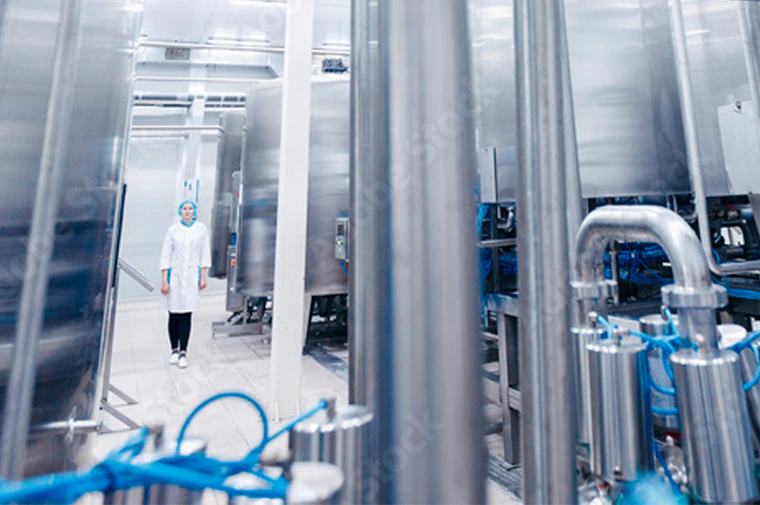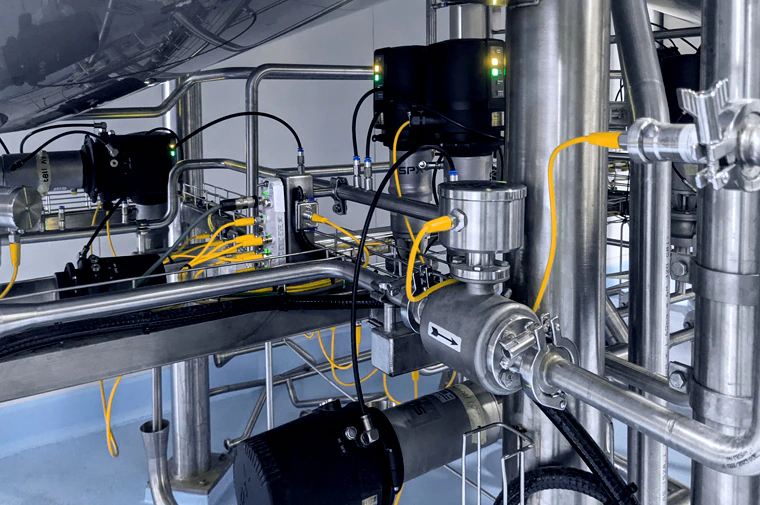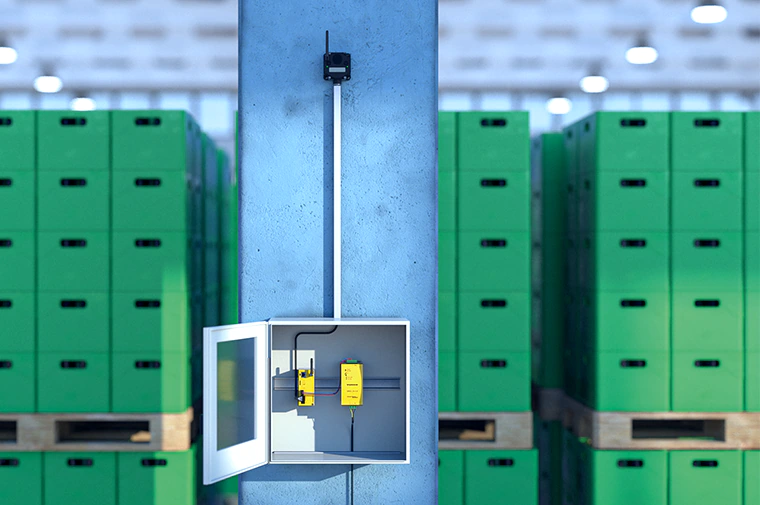
Save instead of fishing in murky water: turbidity sensor ITM-51 from Anderson-Negele
Inaccurate phase separation in the food production industry leads to product losses, which quickly become expensive. These losses can be significantly reduced by switching at the right moment. With the ITM-51 turbidity meter from Anderson-Negele, phase separation is pinpoint accurate.
With each imprecise phase separation between different media, such as milk, cream, yoghurt or water, a certain amount of the product is lost. In addition to the loss of the value of the goods, costs for wastewater treatment and energy costs are generated. Experience shows that a medium-sized dairy or brewery could save several hundred francs a day with optimal use of the raw material.
Active or passive phase separation
Phase separation can be carried out actively or passively. In passive separation, switching is carried out without recording and assessing the medium on the basis of time and volume calculations. A safety buffer must therefore be included, which always leads to loss of product. Active regulation of phase separation is based on analysis of the medium during the process. It registers the change, makes the changing media distinguishable and precisely triggers the switching as soon as the predefined values are reached.

Minimal product loss by measuring in the medium
Turbidity and conductivity sensors play the key roles in regulating phase separation. The more precisely these sensors work, the lower the loss of product. Bachofen offers high-quality measuring technology for both processes and is setting a new standard in turbidity measurement with the Anderson-Negele ITM-51 turbidity sensor. The device is designed for applications with medium to high turbidity values. The sensor is extremely versatile, with a high temperature range between 130°C for continuous operation and 140°C for 120 minutes.
Short response time, high reproducibility and maintenance-free LED technology
The ITM-51 boasts a short reaction time of 0.75 seconds and high reproducibility. The innovative turbidity sensor works according to the backscatter principle, meaning infrared light is shone into the medium, reflected by the particles present in the medium and detected by the receiver diode. The measurement result is not affected by either the colour of the medium or the reflection created in small pipe diameters (from NPS 25). The wear-free LED technology ensures a long service life, even when operating in high temperature ranges. Users have the freedom to choose between the %TU unit for milk products, the NTU turbidity unit (phase separation), EBC (breweries), and %solids (definable solids content for wastewater monitoring).
The savings potential with active regulation of the phase separation using the ITM-51 turbidity sensor is enormous. Using a calculation tool developed by Anderson-Negele, Bachofen can show how enormous it is using individual data for each case. Free of charge and non-binding. Fact-based advice pays off.
Downloads
Discover more products from Anderson-Negele
Areas of application
-
Phase separation of products such as whey, cream or milk
-
CIP return (monitoring of the pre-rinsing water for product residues)
-
Yeast harvest in breweries
-
General quality control
-
Monitoring of filters and seals for breaches
Clear product benefits
-
Front-flush sensor
-
Not influenced by reflections in the case of small nominal values or electropolished surfaces. (Smallest suitable pipe diameter NPS 25)
-
Not dependent on colour (wavelength 860 nm)
-
High reproducibility: ≤ 1% of the final value
-
Switch output (switching point and hysteresis freely adjustable)
-
Analogue output 4...20 mA freely adjustable
-
Two measurement ranges externally switchable
Other focus topics in the area of chemical, pharma, medical technology and food
Uniformity in diversity: the Turck family of fluid sensors
The world of fluid sensors is bewilderingly wide and diverse. There are countless types, features and designs that make it hard to choose the most suitable component for the...
Turck Ethernet Gateway for excom: make way for ethernet in the ex zone
The use of Ethernet in EX zones within the process industry was previously impossible due to safety issues. But now Turck has made a breakthrough with its GEN-3G Ethernet...
Sprinter in ISO Class 3: CSKR cleanroom actuators from THK
Avoiding particles when automating clean room processes is a top priority. With moving machine parts in particular, this key requirement is not that easy to meet since friction causes...
So nothing flares up in production: TSM temperature sensor from Anderson Negele
Process reliability is the top priority in the food and pharmaceutical industries. Disruptions affect producers’ ability to supply and can damage their reputation. Much depends on the reliability and...
Smart and alert: the COBOTTA compact robot
Due to space limitations, the use of robots often proves difficult. Programming is also a critical factor since, depending on the manufacturer, it can be a very lengthy process....
Save instead of fishing in murky water: turbidity sensor ITM-51 from Anderson-Negele
Inaccurate phase separation in the food production industry leads to product losses, which quickly become expensive. These losses can be significantly reduced by switching at the right moment. With...
Reliable means safe: ATEX-certified rotary joints
Due to the friction they create, rotating connections form one of the hazard sources in explosion-risk areas, such as in the chemicals and pharmaceuticals industry. The pre-conditions in gaseous...
Profinet gains a foothold in process automation: S2 system redundancy now with IP67 and IP69K protection
Profinet has established itself as the communications standard for factory automation. Vehicle manufacturers and suppliers have been demonstrating the practical suitability of industrial Ethernet-based data exchange for a number...
Pharmaceutical production: no opportunity for pirates
Fake is on the advance. Even the pharmaceutical industry has to fight against copies and counterfeits. One effective measure is seamless product identification across the entire production and distribution...
Meets the standards and remains ecological: parker legris liquifit
In branches of industry where hygiene is critical, there is no escape from Machinery Directive 2006/42/EC. The keen eye of the legislator is trained in particular on components that...
No risks in the control cabinet: the IM18-CCM control cabinet motor from Turck
Unplanned machine and system downtimes are a costly irritation for producers in the food, beverage and pharmaceutical industries. The cause can often be found in the control cabinet, which...
Connected to health: Parker Rectus connection technology
Regulators consistently prescribe new guidelines and standards to the players in the fields of medical technology and biotechnology. These guidelines and standards are compatible if the system manufacturers can...
Meets the standards and remains ecological: Parker Legris Liquifit
In branches of industry where hygiene is critical, there is no escape from Machinery Directive 2006/42/EC. The keen eye of the legislator is trained in particular on components that...
Measuring on the tank instead of in the tank: precision load cells from Anderson-Negele
Measuring content in process containers with complex shapes or in horizontal positions is not straightforward. Depending on the tank design, using conventional sensors for fill level measurements can lead...
Keeping an eye on the tank: L3 pressure transmitter from Anderson-Negele
If you cannot see what is going on inside tanks in food or pharmaceutical production, the processes are almost impossible to control. To ensure process reliability, the tank contents...
Integrated inline in the process: moisture measurement with Liebherr sensors
Traditional methods of moisture measurement may be justified in non-automated processes. However, these are rarely suited to use on production lines. Liebherr moisture sensors are very different. These function...
Universal I/O: Seamlessly from Ex to non-Ex
Decentralised I/O systems are becoming increasingly widespread across the chemicals and pharmaceuticals industry. Data transfer from explosion-risk process areas, high availability and accurate diagnosis and identification of fault sources...
Good spirits in the background: THK miniature guides
In the medical and health industries, reliable helpers are indispensable. Unseen in the background, they ensure that everything runs smoothly: conscientious, persevering and without ever showing any signs of...
Giving bacteria no chance: aseptic angle valve 6051 from Schubert & Salzer
Compliance with the strict hygiene standards of the food, beverage and pharmaceutical industries is a constant challenge for designers of production infrastructures. Every single part counts. The type 6051...
Safe procedures for machine operation: Turck CMVT-QR20 vibration and temperature sensor
The operation of rotating machines causes vibrations that can cause problems. Excessive temperatures are another risk factor. The CMVT-QR20 vibration and temperature sensor from Turck detects when it becomes...
Now remotely controlled by IO-Link: Positioner 8049 from Schubert & Salzer
In plant operation, personnel deployments on site may be time-consuming and awkward in some situations. This also applies to adjusting and maintaining control valves, which are often difficult to...
Modular alarm design in variations: K100 Pro Beacon hazard indicator from Banner
It is in the nature of industrial production that it is associated with safety risks. Where hazardous substances are involved in production and processing plants, potential risks cannot be...
The safe alternative to the Zener barrier: ATEX-compatible IMX12-SG strain gauge evaluation device from Turck
Strain gauge evaluation devices for use in ATEX zones are a rarity. The divide between ATEX and non-ATEX areas is particularly critical. With the IMX12-SG interface, Turck has unveiled...
Not a drop too much, not a drop too little: FMQ flowmeter from Anderson-Negele
Poor control of flow in production equipment pipelines will affect process efficiency and incur costs. The more accurate the measurement, the safer the production process. The FMQ flowmeter from...
Automated climate monitoring in the warehouse: Condition monitoring with Turck and Banner
When storing sensitive products, continuous temperature and humidity control is essential to prevent product losses. However, doing this manually requires a lot of effort. A complete condition monitoring solution...
Sustainability thanks to precision and control: Conductivity meter from Anderson-Negele
Saving potential through process monitoring - One incorrectly switched valve in the filling plant and it's over: The end product is placed in the wrong container and operation has...
Efficient use of space and energy: Sliding gate valve from Schubert & Salzer
Space and energy usage is becoming increasingly important when planning production plants. Space is a precious commodity and wherever energy can be saved, the opportunity should be taken. One...
So users aren’t left out in the rain: Moisture sensors from Liebherr
The moisture content of bulk materials is measured for more than just quality assurance. It is also relevant to the energy efficiency of processing operations. With the precise humidity...
Fast to market and still Ex compliant: decentralised automation with Turck
Time to market is a key factor for operating successfully in highly competitive markets. Barely is development of a new product over and already it needs to be available...
Faultless identification: Modular RFID
Automation in the chemicals and pharmaceuticals industry can only be successfully driven forward by intelligent solutions that are able to cope with this complex production environment. The answer to...


























